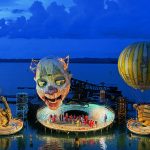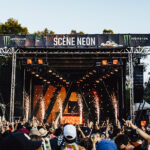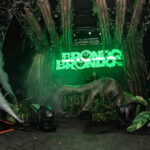It was hard to accurately envision the incredible sight of a ski ramp rising up out of Fenway Park when, on a beautiful sunny fall day in September, the U.S. Ski and Snowboard Association (USSA), along with Boston Mayor Martin J. Walsh and Fenway Sports Management (FSM), announced that the beloved ballpark would host a big air snowboarding and freeskiing U.S. Grand Prix tour event. However, in mid-February, it quickly captured the attention of Bostonians when in the bitter cold the massive freestanding Big Air snow ramp soared to three times the height of the walls of Fenway’s Green Monster.
Polartec Big Air at Fenway, sanctioned as an International Ski Federation (FIS) World Cup for both freeskiing and snowboarding, was the third Big Air stop on the FIS Snowboard World Cup tour and the second stop on the U.S. Grand Prix tour. The competition brought together the top 40 men and top 20 women freeskiers and snowboarders from around the world, including World Cup champions and medalists from the Olympics and X Games competitions. Men’s and women’s big air snowboarding will join other Olympics-sanctioned snowboarding events in 2018, making its Olympic debut at the Winter Games in
PyeongChang, South Korea.
Production director Ed Slapik, with Mission Six production and event management, oversaw all the diverse technical aspects of bringing Big Air into Fenway Park. He worked with all the various production and construction vendors and coordinated with the sanctioning competition teams and Fenway Park’s in-house teams. “Aside from the athletes themselves, which is obviously the focus of the event, there were two rock stars in this show,” comments Slapik. “The ramp itself, and Fenway Park. We wanted to make sure we were maintaining that balance so all of the other production elements are here to highlight those two things.”

Downhill Run
From the very beginning, the ramp’s construction design had to start by understanding the rules of working within the venue itself, explains Slapik. “Fenway Park is a baseball park, first and foremost, and baseball is their number-one concern. It is the reason this building exists, so when you’re putting 800,000 pounds of equipment on their field, you have to do a lot of engineering. The engineering fell into two parts — the structure itself and the engineering of the distribution of weight across that whole baseball field. We had about 88,000 square feet of deck down with custom engineered elements to protect the field and safely support the snow ramp.”
Snow Park Technologies (SPT) provided a lot of input on the design, understanding the things that matter to the snowboarding and the skiing competitors and judges. The trajectory of landing, speed needed, ramp size, location, distance between different stages of the jump and landing. Jeremy Thom, production designer with Lititz, PA-based Atomic, was also involved in the design, helping to meet the sports requirements with the structure and fitting that into the field.
The massive ramp structure was constructed by Auburn, MA-based ConsultantZee, led by owner and project leader Michael Zorena. Using proprietary scaffolding, the ramp ran for 338 feet from the outfield to Fenway’s home plate, and it was taller than the Fenway Park lighting towers. “The keel height is 139 feet, 3 inches high,” explains Zorena. “The in-run is approximately 150 feet long before it hits the kick, which is the moment where the competitors jump. There is an approximately 89-foot corral at the base where they land their jumps.” ConsultantZee is no stranger to large structures, having provided them around the world for events at sensitive venues including the Vatican.
“The challenge mainly on this one was fitting it in the park, obviously, doing so in a timely fashion, and safely,” continues Zorena. “I am very proud that we accomplished all that. The scaffolding was built with craning once we were about 50 feet. We swing the components in little packages to builders.”
The ramp was equipped with both stairs as well as an elevator to get the skiers and snowboarders up to the top. The ramp build took 10 days, and the ConsultantZee construction team averaged around 30 climbers and 10 ground staff for the build.
Steelman Productions out of Keene, New Hampshire also provided labor. “They were unbelievable working on this very, very unique and extremely tall structure,” Slapik says. “It’s 155 feet tall. The top lighting focus, the top fixture, is 150 feet off the ground. Mike Zorena and his team were the big driving force on this. They did a great job.”
Planning and safety is of the utmost importance to Zorena, and wind is an important concern. “Structurally, we’re rated to 105 m.p.h. winds,” he says. “During the last of preparations we had 50 m.p.h. gusts, and we were fine.” To balance the structure, Zorena’s team has 320,000 pounds of ballast on the structure along with guy lines at 50 and 75 feet, and incrementally up the structure.
Slapik and Zorena also note the importance of protecting the Major League ballpark field. “We used a Matrax floor system for the deck supplied by Floor Protection Agency,” says Zorena. “The floor system is rated for 300 pounds per square inch, but in this case, that wasn’t enough. We came up with a higher rating by building an upgraded system using a series of custom built wood bases to spread the load.” Zorena worked with Clark Reder Engineering, Inc., who did all the engineering for the structure.

Light It Up
The power needs for the whole Big Air event as well as the lighting for the ramp was handled by Rocky Point, NC-based Filmwerks International, which specializes in power and site lighting for sporting events. “We’ve been working on outdoor venue lighting for some time at Filmwerks, and for snow sports it’s a bit of a unique lighting application as the consideration are different,” comments Michael Satrazemis, Filmwerks President. “We wanted DMX-controlled LED units for the ramp, and I have a great relationship with PRG, so I called Brian Edwards, [PRG CEO of North American TV and Film] who I’ve known for over 30 years, to come out and work with us on the Big Air event.”

For lighting the ramp, PRG provided 130 Ephesus Lighting Arena Pro 300 white light LED-based sports lights, which PRG modified with improved LEDs and added DMX controls to the units. They gave the even wash of light that the television cameras needed while also meeting the requirements for the competing snowboarders and skiers. Slapik felt that control was a great bonus to this type of event. “Being a night-time competition, live on TV” he explains, “and being able to control the units gave us the chance to do a little more with the lighting. Up until this point, we had to rely on ballasted fixtures that didn’t allow us to be creative. Having control, individual control of each one of these lights allows us to put on a better show; it has just been pretty amazing. “

Of course, hanging these lights on towers mounted along the edges of the ramp was no easy task. “Basically, the lights are over a hundred feet in the air on the scaffold structure,” comments Satrazemis. “With really no extra space to work up there, the light towers were brought up by crane and attached to the scaffold structure. We then used the crane to raise the lights up. It’s Mike Zorena and his team who really deserve all of the credit building this thing; it’s an amazing structure,” he says, noting factors including “the wind and the precision that it takes to get a crane to bring a tower and attach it to another entity. We then got the lighting crew out there to climb these skinny towers up in the middle of the air. It certainly was all done safely, but it is psychological; there wasn’t much underneath you.”
PRG also provided an additional lighting package that included PRG Best Boy Washes, Iluminarc Ilumipanel 180 IP LEDs, Cineo Lighting TruColor LS units and GLP impression 120RXs. These highlighted underneath the structure and put some automated lighting into the corral at the end of the run. The PRG team included lighting technician Daniel Vargas, who handled the DMX control system, and Michael Gionfriddo, the lighting designer/programmer for the ramp. Gionfriddo used a MA Lighting grandMA2 light console.

ECLPS’ Stage Lighting and Video
For the nightly post-competition entertainment stage and two supplemental field level video screens, Slapik and his Mission Six team turned to Rhode Island-based East Coast Lighting & Production Services (ECLPS) to provide the gear, crews and the concert lighting design. ECLPS also supplied two supplemental video screens on the field level. “We’ve worked together with Mission Six previously on a number of high profile events and provided them with lighting services and designs,” says Robert Morrisey, owner and president, ECLPS. “We were very pleased that Ed was confident enough in our track record to have us work on the Big Air event.”
Once the design came together, the production team realized that the large ramp was going to block a number of the Fenway Park video screens, so they would need some supplemental screens for both the competition as well as for the concerts each night of the event. “We purchased 130 of the Elation Professional ETP6IP video panels for the two screens,” says Morrisey. The ECLPS team worked closely with Walter “Red” Darrin, product specialist, LED Video Screens & Broadcast Lighting with Elation and also with Healy Sales on acquiring the new LED video screens.
“We used the new 6mm video panels to build two screens—a 25-foot-high-by-14-foot-high screen and the other was 16 feet wide and nine feet high. They worked great for this event,” comments Nathan Almeida, stage lighting designer/video technician with ECLPS. The processing for the video wall was done via Elation NovaPro HD Video Wall Processors. “The main challenge was man versus nature,” laughs Almeida. “The gear held up great in the sub-zero weather, and I think we all produced some great shows. The whole project was a real team effort.”
Slapik was very pleased with the results. “The stage was on the third base side, adjacent to the ramp. I simply told Nate to remember the Green Monster is the backdrop for the stage. Just keeping the design at Fenway, not anywhere else. He understood that and his design really accentuated that. He and the ECLPS team did an exceptional job.”
Almeida’s lighting equipment for the concert stage included Robe Robin 1200 LEDWashes, Martin MAC Viper Profiles and Air/FXs, Clay Paky Sharpys, Altman Single Cell Ground Cycs and Colortran 8-inch 2kW Fresnels. He ran his show with Avolites Sapphire Touch and Pearl Expert consoles. The crew from ECLPS included along with Almeida, Vanio Tavares (video technicians), Alicia Colantonio (stage associate lighting designer/programmer), Kyle Mello (head lighting technician) and Ed Boulet and Jenel Barry (lighting technicians).
For Morrisey it was a real honor to work on this impressive event in Fenway Park. “Although ECLPS is a Rhode Island-based business, the bulk of our work is conducted in the Boston area, and it was extremely important to us to have things go off without a hitch at this iconic ballpark,” he comments. “I couldn’t be more proud of the performance of my team on this historic event.”


